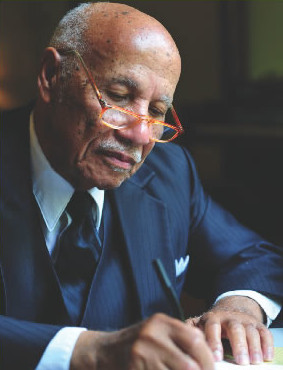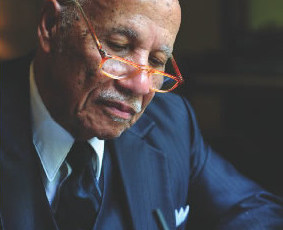
Dr. Sonnie Wellington Hereford III was born on January 7, 1931, in Huntsville, Alabama. Despite growing up in a house without running water or electricity and having to walk 7 miles to a school located next the the city dump with no library or cafeteria, Hereford overcame theme and many other obstacles to become a medical doctor, educator, and civil rights activist.
On September 3, 1963, Hereford and his six year-old son were met by a mob of angry parents and students when he tried to enroll his son in an all-white school. He returned over the next several days only to find the school locked and guarded by armed state troopers dispatched by Governor George Wallace. Seeking help, Hereford contacted the federal judge that issued the order to desegregate Huntsville City Schools. The following week, on Monday, September 9, 1963, Hereford successfully enrolled his son at Fifth Avenue School making Sonnie Hereford IV the first African American student admitted to a previously all-white public school in Alabama.
Understanding the importance of education with the desire to become a physician, Hereford worked hard and graduated number one in his class. He applied to the University of Alabama with the hope of entering their pre-med program and, although he was his class valedictorian, his application was rejected because of his race. Hereford enrolled at Alabama A&M University, graduated in 2 years, and went on the receive his medical degree from Meharry Medical College.
In 1956, Hereford began his medical practice in Huntsville, Alabama. At Huntsville Hospital, the African American doctors – both of them – were not allowed to eat in the hospital cafeteria. Only one room was available to African American patients; it served as the delivery room, the operating room and the emergency room. A patient who had been prepped for surgery would sometimes have to be taken off the table and wait while an emergency, such as a woman in labor, was attended to. During his 40+ years of practicing medicine, Hereford delivered over 2,200 babies and served as the attending physician at both Oakwood Collage and Alabama A&M University. He also provided medical care to marchers during the Selma to Montgomery march and performed the medical exam for Vivian Malone as she prepared to matriculate at the University of Alabama.
On January 3, 1962, the Congress on Racial Equality (CORE) came to Huntsville to help end segregation in the city. It only took a few days of sit-ins and protests before more than 15 students had been arrested. In response to the arrests and the lack of interest by Mayor Searcy to assist with ending segregation in Huntsville, members of the community formed the Community Service Committee (CSC). Hereford was selected as one of the leaders of the new organization. The CSC raised thousands of dollars to bail out jailed students and organized prayer marches and picket lines at stores that discriminated against African Americans. The CSC also worked with Mayor Searcy to create a bi-racial committee and made sure students remained nonviolent at lunch counters and on the streets.
The CSC’s attempts to end segregation weren’t very successful initially. In an effort to gain national attention, Fr. John Cashin and Hereford devised a bold plan. On April 11, 1962, Hereford’s pregnant wife, Martha, Dr. Cashin’s wife, Joan, and their 4 month old daughter, along with Alabama A&M student, Frances Sims (now Washiri Ajanaku) staged a sit-in at the Walgreens’ lunch counter. They were all arrested, but as planned they refused to pay bail and remained in jail for two days. The headlines in the Huntsville Times read, “Pregnant Woman Sentenced to Jail.” Their story was picked up by the national media, and with a national audience, the CSC’s sit-ins and their Eater Boycott, also called “Blue Jeans Sunday Boycott,” gained traction. Within a few weeks local establishments had lost over $1 million in profits. On July 9, 1962, the Huntsville city council began a three-day desegregation trial. Later that month, Huntsville became the first racially integrated city in Alabama.
On March 11, 1963, Hereford filed a lawsuit in his son’s name to integrate the public schools in Huntsville. As a leader of Huntsville’s civil rights movement and names plaintiff in the school desegregation lawsuit, Hereford was the target of death threats and other intimidation. On August 13, 1963, in federal court in Birmingham, Judge H.H. Grooms of the Northern District ruled from the bench, siting the Brown vs. Board of Education ruling and order Huntsville public schools to integrate. On Monday, September 9, 1963, Hereford enrolled his son at Fifth Avenue School and public school integration in Alabama had begun. Fifty-one years later, on December 16, 2014, Hereford and his son attended the groundbreaking ceremony of the Sonnie Hereford Elementary School in Huntsville, Alabama.
Resources
- Beside the Troubled Waters: A Black Doctor Remembers Life, Medicine, and Civil Rights in an Alabama Town by Sonnie Wellington Hereford III and Jack D. Ellis
- August 28, 2013 article by Steve Doyle of AL.com/Alabama Media Group http://blog.al.com/breaking/2013/08/huntsville_civil_rights_pionee_1.html
- Notre Dame Magazine “My Walk Into History” Published: Spring 2007 Author: Sonnie Wellington Hereford IV ’79 http://magazine.nd.edu/news/9874-my-walk-into-history/


